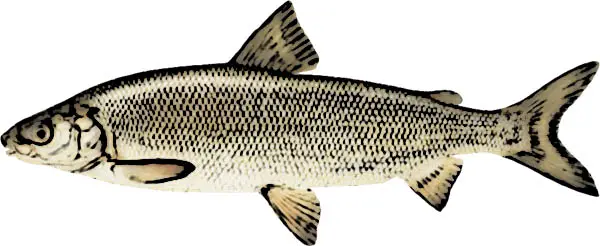Lake whitefish are a popular sportfish to target that are found throughout the northern United States and parts of Canada. They are prized as a commercial fish due to their delicate flavor, but also make a great gamefish for recreational anglers as well. If you’re targeting whitefish on your next fishing trip, then you need to read this. In this guide, we will cover how to identify lake whitefish, where to catch them, their seasonal patterns, the equipment you will need, and some additional tips to help you catch them.
Lake Whitefish Identification
Whitefish are sometimes called “humpback” because of their small head size and large body. They are usually an olive to pale green-brown color and have white fins with dark edges. They also have a forked tail.

On average most lake whitefish weigh around 4-5 lbs. Though they can reach sizes up to 15lbs if you’re extremely lucky.
Where to Catch Whitefish
Lake whitefish are common throughout Canada and the Northern United States. They are also prominent throughout the great lakes regions in the U.S. They reside in deeper, cool, oxygenated lakes. In some areas, they may reside in brackish waters, but this is not as common. They are known to be bottom feeders, so they usually reside near the bottom in the lakes they inhabit.
Feeding Habits
As we stated earlier, lake whitefish are bottom feeders. They tend to eat anything that is near the bottom of the lake. They will commonly eat clams, snails, mussels, shrimp, larvae, mayflies, midges, and small fish.
Seasonal Patterns
Fall
Lake whitefish tend to spawn in the fall or early winter, depending on the area. Usually, this occurs when the water temperatures fall below 45 degrees F. They prefer to spawn in shallow rocky areas that are near the shores of lakes. Look for them in areas with less than 25 feet of water. Sand or rock bottomed lakes are good places to target them.
Winter
In early winter you can still find whitefish near their spawning grounds near the bottom-feeding on whatever they can find (usually eggs). As you get further into the season the whitefish will begin to move into deeper sections of water.
Spring
Spring can be a difficult time to catch whitefish if you’re not looking in the right areas. Often they will migrate into rivers and streams. You can also fish for them in shallow areas that are less than 20 feet deep. When the temperature warms up they will begin to move into deeper waters
Summer
In the summertime, whitefish prefer deeper well-oxygenated environments in lakes. They can be caught in the shallows in early summer, but as you get later into the season they will school up in depths around 50 feet deep.
Best Time to Catch Whitefish
Lake whitefish are known to be quite actively feeding at night, which makes night time one of the best times to catch them. They will come out from their deeper waters to feed, which presents a great opportunity to target them. They also can be easily caught early in the morning.
Lake Whitefish Equipment Recommendations
Rods and Reels
Spinning gear is all you really need to catch lake whitefish. A good medium-power spinning rod around 6 to 7 feet is a great option. The bite of whitefish is very light so you need to make sure that your rod has a sensitive tip that will allow you to feel their bite.
Lures and Baits
Spoons
Spoons are one of the most popular lures among anglers for catching whitefish. Usually, these are used either jigging or trolling when the whitefish are hanging out in deeper waters.
Spinners
A good inline spinner can also be effective, especially when the whitefish are feeding in shallower waters. Just remember that whitefish don’t have very big mouths, so smaller spinners tend to work best.
Jigs
Another popular lure for targeting whitefish is the tried and true jig. Again, whitefish have small mouths so stick with smaller jigs. Around 1/16 ounce will work fine.
Live Bait
Sometimes live bait is the best choice for catching whitefish or any other fish for that matter. For whitefish salmon eggs, maggots, and waxworms are productive.
Fishing Line
Monofilament line is widely used for catching whitefish. A 6 to 10-pound test line is a safe bet. Some anglers will opt for braided or fluorocarbon lines as well.
Hooks
The key point that you need to remember is that whitefish have small mouths, so your hook size has to be small. Something around a number 6 is a good size.
Whitefish Fishing Tips
Think Small
Smaller lures, smaller bait, smaller hooks, lighter lines. Think small when targeting whitefish. They have small mouths and have a preference for smaller things. If your bait, or your line is too big it will spook them and they won’t bite.
Gentler Hook Sets
If you get too overexcited and set your hook too aggressively you could end up tearing your hook right out of their mouth. You have to use gentler hook sets when hooking whitefish. Gently pull on the line when you feel action, and your hook should set just fine.
Patience
Whitefish are known to be easily spooked, so if you’re fishing for them, don’t be too jerky with your retrieves. Slower retrieves tend to work best. Bring your lure down to their level and slowly entice them to give chase. If you start to work your lure too fast it could end up scaring them away. That’s why it’s important to be patient when fishing whitefish.
Related Posts:
Pike Fishing Tips
Coho Salmon Fishing Tips
How to Catch Lake Sturgeon
